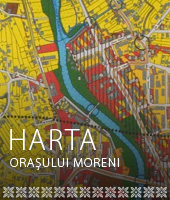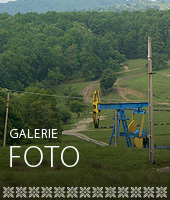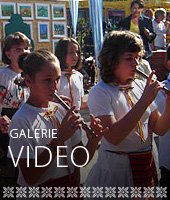Events Calendar
vizite
Vasile Moldoveanu
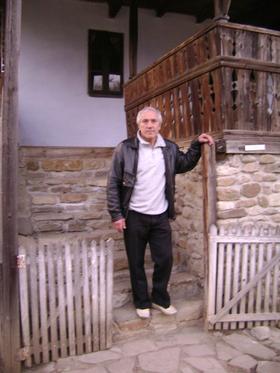
Vasile Moldoveanu is one of the last wood carvers who still make the hearth icons, the oldest pre-painting icon on the glass. It is a Christian element created by the peasant as a spiritual shield that sets it on the chimney to prevent the evil spirit from entering the house. The peasant broke an oak wood and on a piece of it scraped a cross, a seraphim, an archangel, or a protector-saint told us the craftsman.
Vasile Moldoveanu, wooden sculptor from Moreni, Dambovita. He has a professorship of craftsmanship, but he has also learned to mold wood from his grandfather's ten years. Today he is trying to convey the craft of other children, but he complains somehow that he is losing to the computer.
"There is a lot of hard work in the wood processing, the traditional crafts have disappeared, we do not have the village blacksmith, the nerd, the carpenter and the carpenter of the village, today you can find tools in the shops, but you can not adapt them to the pattern of the traditions," says Moldoveanu. He makes the tools necessary for the crafts himself. He also says that it is necessary to preserve his tools in honey, and the wood takes him out of the woods. Trojls are carved from solid wood.
His work also enjoyed appreciation, benefiting from invitations to certain events from the former US ambassador to the United States, Michael Guest. Besides, Moldoveanu has been studying his craftsmanship in all areas of Romania. His eyes turn on when he speaks of the hearth icon, which the olteni make of hard wood to protect the house from the evil spirits that can enter the house of the house or the cross of the hand used by the priests when they went by baptism through the village. "Do you see how interesting it is in the area of Bucharest? The cross has the symbols of the Holy Trinity in the upper part, and only the sun and the moon are at the bottom", says excited by a model discovered through his travels.
In recent years he has participated in many national and international fairs and exhibitions:
The Fair "Traditions and Flowers", opened in Cişmigiu and Herăstrău (March 26 - April 2, 2010).
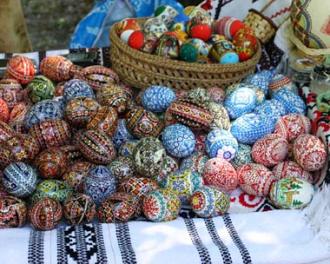
The City Hall of the Municipality of Bucharest, through the Center of Tradition and Folk Creation, organized the Traditions and Flowers event in the Cişmigiu and Herastrau parks. On the threshold of the Easter holidays, the Bucharest residents were expected with a flower show, a craftsmen fair, free carriage rides, traditional music And fanfare. And for the little ones, the organizers have prepared theater plays for children, pony rides, face paintings and many other surprises.
The Traditional and Flower Fair, opened in Cismigiu and Herastrau parks, gathered many artists from different parts of the country, such as potters, sculptors, sculptors, chefs who love Romanian traditions and want them to be forgotten.
A great art lover is also Vasile Moldoveanu, a sculptor from Moreni, Dâmboviţa County, who successfully represented Romania in all its places. Vasile Moldoveanu spoke with Infonews reporters about his work and how he came to be known, saying: "Art makes me feel that I do not live for nothing"
Infonews: What do you do?
Vasile Moldoveanu: I only deal with traditional-Romanian art, old technique and customs of my area. I like the painting between sculpture and painting. I paint in winter and in summer I like to sit out in the open to sculpt.
How was the passion for art and traditions born?
I have a passion from childhood from my grandfather, who was a great craftsman of woodworking. In our country in Muntenia, the wood was being traded and everything was a whole lace. I fascinated these things, and easily, I fell in love with the sculpture.
Where do you get the materials from?
I have the "Garden of Heaven" near. Our area is forestry, I can easily find everything I need.
Do you have a ritual that you respect when you work?
It depends very much on what I intend to work on, to know what wood I need, but generally go to the woods, take my log, cut it, dry it, and then select it. For example, religious objects are made of willow wood, which by nature of dogma is a wood blessed by the Mother of God.
After guiding you?
When you work, you need to follow certain symbols that reflect traditions. They do not do that by the ear. They are holy, spiritual things that are put in place of honor.
Which objects do you define best?
All the things I do are passion and love for art and traditions. The object with which many people identify me and which I managed to bring to light is the hearth icon, called so because it is placed in the kitchen. This makes it a hardwood, I paint it diffuse in water colors and a canned bee wax to withstand in time.
Have you participated in other exhibitions?
I have participated in many important events in Spain, Italy, France and of course in Romania. Everywhere I was appreciated, and that made me feel fully satisfied. Art gives you satisfaction, you feel you do not live for nothing.
International Trade Fair of Traditional Craftsmen, Gabrovo Bulgaria - 2010, 2011
The ASTRA National Museum Complex, through the ASTRA Transylvanian Civilization Museum, has been participating since 2001 occasionally and since 2007 each year at the International Fair of Traditional Crafts in Gabrovo, Bulgaria, organized by the Etar Architectural and Ethnographic Complex in Gabrovo.
During the five days of the fair, almost one hundred popular folk makers in the Gabrovo region compete, year after year, in handicrafts and exchange experience with those from other countries: France, the Czech Republic, Ukraine, Romania, Japan, Morocco, Russia , Republic of Moldova, Lithuania, Greece, Portugal, Spain, Poland.
The atmosphere of the fair is complemented by every edition of Bulgarian folk ensembles.
Every year at the fair there is a competition between the most skilled craftsmen in wood or weaving, and so on. The contest consists of reproducing a collection of pieces from the Gabrovo museum, the winning master being rewarded with the fair trophy, a silver bell, and the right to organize a personal exhibition in the next tourist season.







